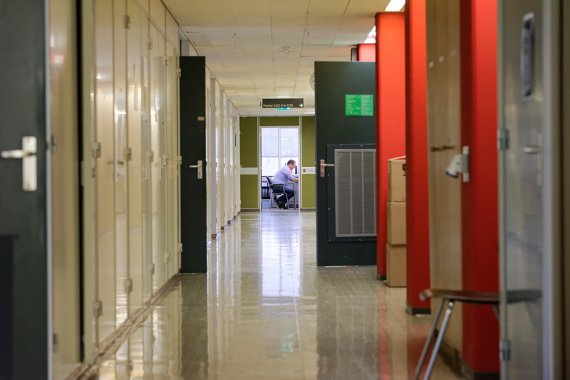Photos: Guy Ackermans and Rob Ramaker
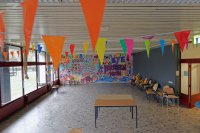
This was once Biotechnion’s busy canteen.
The drawing of Helix has been hanging near the lobby of the Microbiology department for so long that sunlight has bleached it into illegibility. Actually, the department’s researchers should have been sitting in that new building on the campus long ago. But last August the planned relocation was cancelled at the last minute; the air quality management in the new building was not functioning properly. And so the academic life of the Dreijen was unexpectedly prolonged.
These days, working up on Wageningen’s hill is nothing like it used to be back in the glory days. No official lectures are held here and many researchers have already left. In the buildings that are still in use, there are just eight chair groups. Accordingly, on a damp December afternoon there is not a soul in sight on the Dreijen square. Most of the parking spaces for cars and bicycles are vacant. Minutes later two students cycle past, temporary residents of the former Computechnion. A little while later two researchers brave the rain to smoke a cigarette.
Deserted
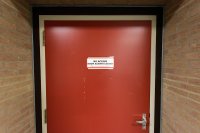
More and more rooms in Biotechnion are being locked.
‘It is so boring here,’ says Christie Nguyen Minh, PhD candidate at Organic Chemistry in the Chemistry building. Together with a colleague, she works in a room on an otherwise deserted corridor. Nguyen Minh is frustrated that their relocation has been postponed; she feels the campus must be a much more inspiring place to work. It offers more colleagues and students to talk to, and there are lectures and activities.
Farther along in the Chemistry building, at Microbiology, they have been able to see an upside to their situation. The department will soon have to fit into Helix. For the time being they can enjoy having plenty of space, say researchers Nico Claassen and Stan Brouns, who are sitting down to lunch in the communal coffee corner.
Here and there in the corridors are the silent witnesses of the abandoned move. The faded construction plan, a pallet of unused moving boxes. Last October a second target date passed by unnoticed. Since then no new date has been set and many microbiologists have the feeling this is their long-term home.
Sunlight has faded the construction plan for Helix
Planning in disarray
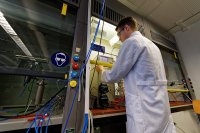
PhD candidate Martijn Diender had to change his plans because he cannot relocate his test set-ups midway.
For Sidharam Pujari, postdoc at Organic Chemistry, the uncertainty is a problem. He likes to plan his research projects a year in advance because he needs to purchase and install expensive equipment. Similarly, Martijn Diender, PhD candidate at Microbiology, has had to change his plans. In his project he is studying a bacterium that grows on the gasses carbon monoxide and hydrogen. To enable him to track this process safely, he is building a special bioreactor that cannot simply be moved. Wisely, he planned to do this work after the move but now he is having to get started in January. ‘Fortunately, this is not messing up my entire PhD,’ says Diender. ‘It’s early days for me yet and I can still be flexible.’
Filth
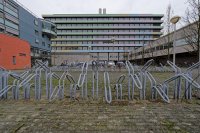
On the campus you have to fight for a space to park your bicycle; at the Driven there is plenty of choice.
Whereas the Chemistry building is still reasonably fully and in good condition – even the canteen has reopened at the request of the university – other buildings on the Dreijen are showing signs of decay. In De Valk part of the ceiling has fallen down and Agrotechnion is plagued by localized leaks.
The most spartan conditions are to be found in Biotechnion, whose top floors have been vacant since September 2013. On the other floors more and more stickers are appearing. They read: No access; room always locked. Here and there the corridors – where calendars from 2013 still hang and the way is occasionally barred by a shelving unit – make a spooky impression.

Biotechnion’s top floor has been vacant since 2013.
Nonetheless, here too people are still working. On the ground floor Iris Rijnaarts and Malou Thijssen, Master’s students of Nutrition and Health, are preparing a meeting. What do they think it is like working in Biotechnion? ‘Shit,’ says Rijnaarts with a laugh. It was initially cold because the central heating gave up the ghost, and now it is uncomfortably warm. ‘I frequently have a headache when I’m sitting here working. And that is even more annoying than the filth.’ By filth, she means the bugs and the grubbiness that leads them to suspect that the cleaning is less thorough than it used to be. Rijnaarts points to a bucket containing some dirty cloths; it has been left standing in the corner for ages.
Bye Biotechnion
Nevertheless, the duo can still laugh about the situation. Like many occupants, they are doing their best to keep up their spirits. Some of their fellow students along the corridor enjoy the peace and quiet. Where else can you work on your thesis without being disturbed? Besides, for the time being there is no alternative. The garlands in the former canteen, where ‘Bye Biotechnion’ has been written on the wall in big letters, are evidence of a farewell party that did not get into its stride and now seems never-ending.

